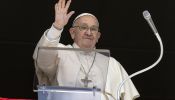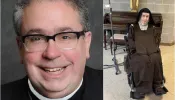Americans meeting each other on the street will typically begin their encounter with a friendly “hello,” a word probably derived from a German word used to hail a ferryman. But, in other language groups, different greetings are used. Italians greet each other cheerfully with “ciao.” Both Jews and Arabs greet one another with “peace.” Albanians say “long life.” The people in Bhutan ask, “Is your body well?” In Taiwan, the traditional greeting is, “Have you eaten?” In fact, if you wanted to “hello” in all the different languages, you would probably have to learn at least 2,796 greetings.
Each language has its own way of greeting to begin a conversation. So no surprise, therefore, that, when we begin Mass, there is a greeting. After all, the Mass is a conversation. God speaks to us in His Word and we respond. However, the greeting at the beginning of Mass is ritualized. It is not left to the priest simply to begin by saying, “Hello” or “Good Morning.” And this is for an important reason.
When someone comes into the presence of the Queen of England, a slight bow or curtsy is expected along with the proper address, “Your Majesty.” When someone meets the governor of any State in this country, a handshake along with the proper address, “Governor,” or “Your Excellency” is used. Civilized people observe proper etiquette. These are formal occasions and they require a ritualized greeting. So too at Mass, for we are coming into the Presence of God.
The Mass is not an informal gathering of a group of people. It is a sacred moment before God. This is why the Missal gives the formal, stylized greeting that the priest is expected to use. There are three options available. Each option highlights the special nature of our gathering for Mass.
After the sign of the Cross, the priest may greet the people with the words “Grace to you and peace from God our Father and the Lord Jesus Christ.” This greeting is thoroughly Pauline. Paul begins eight of his letters with this expression (Rom 1:7; 1 Cor 1:3; 2 Cor 1:2; Gal 1:3; Eph 1:2; Phil 1:2; 2 Thess 1:2; Phlm 3).
This biblical greeting places God the Father and the Lord JesusChrist in parallel positions. From a literary point of view, the greeting gives equality to the Father and the Son. Thus, there is affirmed the Church’s unbroken belief in the divinity of Christ. Jesus, who suffered, died and rose for our salvation, is truly man and truly God. He is one divine person with two natures. When we use this expression in Mass, we unite ourselves with all Christians who, from the birth of the Church to our present day, confess, with Thomas, that Jesus is our Lord and God (cf Jn 20:28).
Furthermore, the greeting uses the title “Father” for God. Thus, it echoes the constant and distinctive way that Jesus himself spoke of God. While the Old Testament did teach the fatherhood of God (e.g. Dt 32:6; Ps 68:5; Is 63:16), the idea of the fatherhood of God comes to full bloom in Jesus. In the gospels, most especially in John’s gospel, Jesus speaks not only of God as Father, but also of his Father in a unique way.
After his resurrection, Jesus says to Mary Magdalene, “I am returning to my Father and your Father, to my God and your God” (Jn 20:17). Jesus’ relationship to the Father is not the same as ours. Jesus is the eternal Son of the Father. We are the adopted sons and daughters of God. Through Baptism, God becomes our Father and we become his children. In the Liturgy, this relationship becomes more intense as we come to share more deeply God’s own life. Thus, the greeting “Grace to you and peace from God our Father and the Lord Jesus Christ” makes us aware of the mystery of God’s own life made present to us in every Eucharist.
Reprinted with permission of The Beacon, newspaper of the Diocese of Paterson, N.J.











